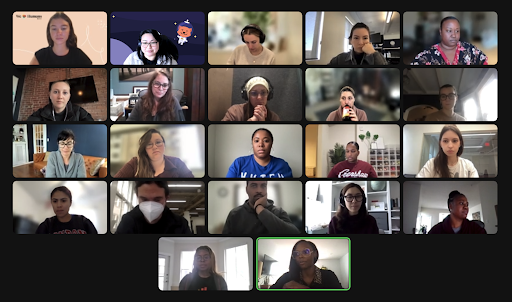As the supply chain ground to a near halt during the COVID-19 pandemic, the transportation and logistics industries have been front and center. Headlines blared news of delayed shipments and product shortages just as one long-standing challenge for the sectors grew progressively worse: a truck driver shortage.
In October, the American Trucking Associations estimated that the shortage will hit an historic high this year — more than 80,000 drivers total. The reasons for the shortage, according to the trade group, include an aging workforce that’s retiring and drivers moving to other industries with a better work-life balance.
These days, the industry is competing for talent as other sectors shift to remote work or add new roles that offer competitive wages and a job that doesn’t involve driving all night, said Kimberly Prescott, founder and President of Human Resources consulting firm Prescott HR. Customer service workers are answering calls from home, and sprawling warehouses, opened to serve the e-commerce explosion during COVID, let employees spend their off-hours at home instead of on the road.
“Now people have a lot more options with a lot more flexibility, and it doesn't require a lot of skill,” Prescott said.
All of this adds up to tremendous challenges for HR teams in transportation and logistics. Here are some of the top hurdles — and how to overcome them.
Staffing and Employee Retention
Transportation companies desperately need workers. In August 2021, the US Bureau of Labor Statistics (BLS) counted 537,000 job openings in the transportation, warehousing, and utilities category — up from 283,000 in August 2020. The quit rate among transportation workers in August 2021 hit an all-time high at 3.7%, the BLS reported.
Strategies and initiatives aimed at hiring workers and keeping them on board often go hand in hand. Here’s what experts advise.
1. Rebrand yourself.
Some might see working in warehousing or truck driving as a dead-end job, but there’s plenty of room for growth. Transportation and logistics companies must rebrand themselves to highlight that they don’t just provide a paycheck, but a career, too, said Prescott.
Establishing career paths is one way to rebrand — demonstrating how people can move up internally from warehouse worker to manager, or long-haul trucker to onsite supervisor, for example. Showcasing those opportunities during the interview and onboarding processes and following through by promoting qualified candidates is critical.
Being intentional about company image also helps. To attract new team members, leaders at logistics company Mercury Business Services updated its original 1980s-era logo and refreshed its marketing message to highlight how its employees are supporting the important work of its primary clients — healthcare companies. The company’s offices also got an update.
“We’re in Boston. We’re competing with early-stage startups,” said Josh Medow, CEO at Mercury Business Services. “So we’re trying to make it much more inviting, as much as we can.”
2. Think about your benefits.
During COVID, Mercury Business Services also bolstered its employee benefits. “Transportation companies typically operate on a low margin. We run pretty lean,” said Medow. “We knew if we lost a couple of key people, it would overload everybody else. So we were really proactive about giving out bonuses and being flexible with work-life balance.”
That also includes letting office staff work from home when possible and deploying new technology, including a payroll system, that makes daily tasks easier. New hires don’t have to go into the office to fill out forms; they can sign up for benefits from home. Office staff who are paid hourly and work remotely can clock in and out through the platform. And it strips away the need for paper paid time off (PTO) requests or manual updates to healthcare plans because it’s all done through the system. This focus on improving the employee experience and workplace environment will continue to be key to recruiting younger workers, said Traci Secia, Mercury Business Services’s Vice President of Finance.
3. Reconsider requirements.
Reckless driving charges and other legal trouble can disqualify potential employees from some jobs in transportation. But transportation and logistics companies aren’t just hiring drivers bound by federal rules. Employers should consider opening up their other positions, like laborers, janitorial staff, or customer service representatives, to people with a criminal record, Prescott said. The Society for Human Resource Management (SHRM) offers tips for hiring people with criminal histories. “This is an opportunity to tap into another pool of candidates that might not otherwise be available to you,” Prescott said.
4. Update your culture.
Technology is transforming the transportation industry. According to Logistics Management Magazine’s 30th Annual Study of Logistics and Transportation Trends, nearly 88% of respondents said that technology adoption is necessary to compete in today’s marketplace. As this transition continues, the sectors’ culture needs an update to attract technology-savvy employees and keep employee engagement high, said Liz Palmieri, talent optimization consultant with MVP-Results, a talent strategy firm. One way to build culture, she said, is to invest in workforce development and provide a stable work environment.
For employees eager to move up in their career, HR management can build opportunities for skills development through community college classes or mentorship programs. For those who are happy where they are, look for ways to ensure that their schedules remain stable, so they can plan their lives around work.
Training Talent
Training employees on new technology — or just their job’s basic duties — isn’t always easy. These HR practices can help.
1. Implement performance plans.
Even after perusing resumes and conducting interviews, it can be difficult to determine whether somebody has the required skills, Medow said. When a new hire slips up at Mercury Business Services, leadership moves them into a performance improvement plan that comes with a three-strikes-and-you’re-out rule. “As soon as we start having an issue, we try to solve it,” he said. Quick action, said Medow, swiftly uncovers whether there is a training or management issue, or that the worker isn’t right for the job.
2. Make changes gradually.
The transportation industry often appeals to workers who appreciate steady, stable routines, said Palmieri. To get buy-in when new technologies or workflows are deployed, be mindful of those traits, she advised. Investment in training is key, and so is giving workers time to prepare for change. “Don’t rush the process,” she said.
Rules Compliance
Trucking companies and other transportation businesses have a host of government regulations to comply with — from required breaks for drivers to driving-hour limits — which can require reams of paperwork. Without the right systems in place to track a driver’s activities, transportation and logistics companies can fall out of compliance, facing fines and other penalties. Government officials issue thousands of violations each year, according to the Federal Motor Carrier Safety Administration, part of the US Department of Transportation (DOT).
Using technology can limit an organization’s risk, Prescott said. Platforms can record drivers’ activities in real-time and trucks can even be equipped with devices that monitor their movements and provide leaders with the information they need to ensure compliance.
—
HR professionals and leadership teams in the logistics sector and the transportation and trucking industry certainly face plenty of challenges. But Medow is optimistic. Headlines about supply chain woes may just lure more job seekers to the sectors, eager to find solutions.
“The more logistics and supply chain is in the news, the better things are for us,” Medow said. “People will think about the challenges they want to solve. And I think that’s going to help the industry in the long run.”







